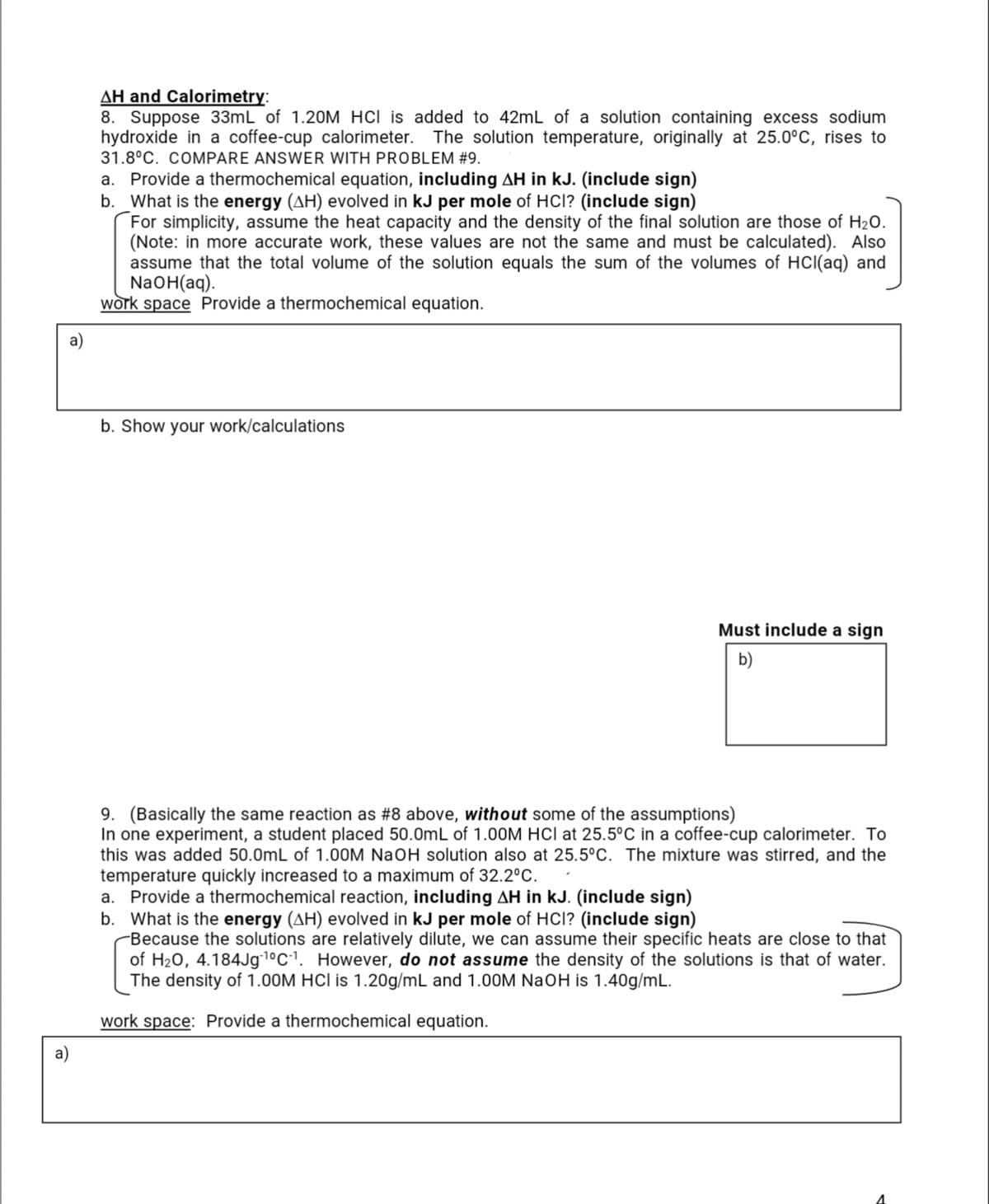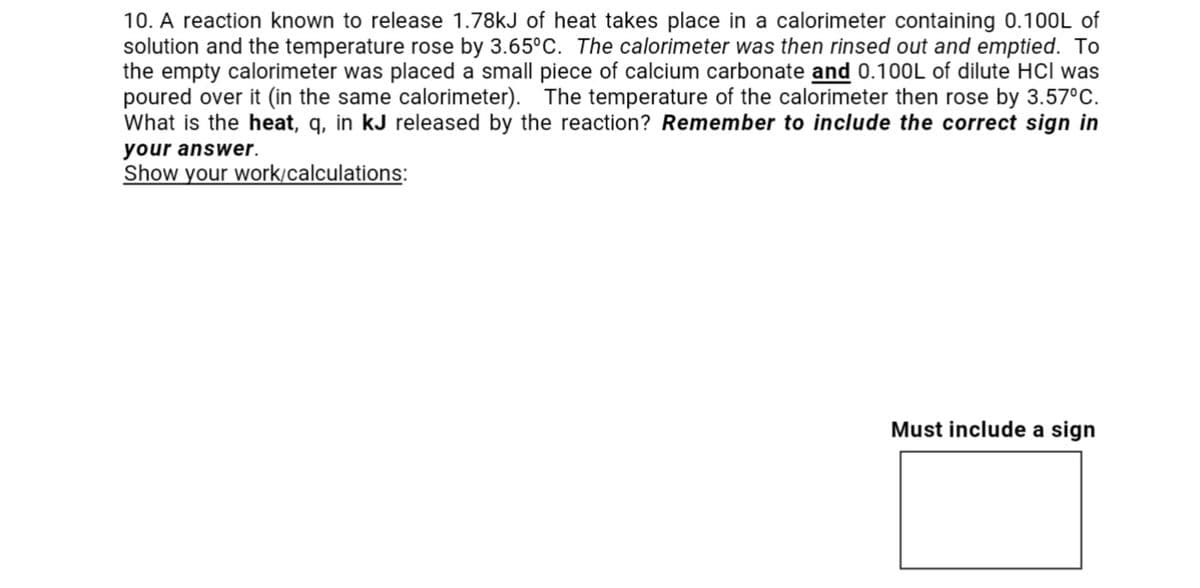AH and Calorimetry: 8. Suppose 33mL of 1.20M HCI is added to 42mL of a solution containing excess sodium hydroxide in a coffee-cup calorimeter. 31.8°C. COMPARE ANSWER WITH PROBLEM #9. a. Provide a thermochemical equation, including AH in kJ. (include sign) b. What is the energy (AH) evolved in kJ per mole of HCI? (include sign) For simplicity, assume the heat capacity and the density of the final solution are those of H20. (Note: in more accurate work, these values are not the same and must be calculated). Also assume that the total volume of the solution equals the sum of the volumes of HCI(aq) and NaOH(aq). work space Provide a thermochemical equation. The solution temperature, originally at 25.0°C, rises to a) b. Show your work/calculations
AH and Calorimetry: 8. Suppose 33mL of 1.20M HCI is added to 42mL of a solution containing excess sodium hydroxide in a coffee-cup calorimeter. 31.8°C. COMPARE ANSWER WITH PROBLEM #9. a. Provide a thermochemical equation, including AH in kJ. (include sign) b. What is the energy (AH) evolved in kJ per mole of HCI? (include sign) For simplicity, assume the heat capacity and the density of the final solution are those of H20. (Note: in more accurate work, these values are not the same and must be calculated). Also assume that the total volume of the solution equals the sum of the volumes of HCI(aq) and NaOH(aq). work space Provide a thermochemical equation. The solution temperature, originally at 25.0°C, rises to a) b. Show your work/calculations
General Chemistry - Standalone book (MindTap Course List)
11th Edition
ISBN:9781305580343
Author:Steven D. Gammon, Ebbing, Darrell Ebbing, Steven D., Darrell; Gammon, Darrell Ebbing; Steven D. Gammon, Darrell D.; Gammon, Ebbing; Steven D. Gammon; Darrell
Publisher:Steven D. Gammon, Ebbing, Darrell Ebbing, Steven D., Darrell; Gammon, Darrell Ebbing; Steven D. Gammon, Darrell D.; Gammon, Ebbing; Steven D. Gammon; Darrell
Chapter6: Thermochemisty
Section: Chapter Questions
Problem 6.109QP: A 21.3-mL sample of 0.977 M NaOH is mixed with 29.5 mL of 0.918 M HCl in a coffee-cup calorimeter...
Related questions
Question
Can someone please explain how to do this in detail and show me how to do the work. I have 2 more problems like this and I need to learn how to set it up and complete it and why.
Thank you in advance!

Transcribed Image Text:AH and Calorimetry:
8. Suppose 33mL of 1.20M HCI is added to 42mL of a solution containing excess sodium
hydroxide in a coffee-cup calorimeter. The solution temperature, originally at 25.0°C, rises to
31.8°C. COMPARE ANSWER WITH PROBLEM #9.
a. Provide a thermochemical equation, including AH in kJ. (include sign)
b. What is the energy (AH) evolved in kJ per mole of HCl? (include sign)
For simplicity, assume the heat capacity and the density of the final solution are those of H20.
(Note: in more accurate work, these values are not the same and must be calculated). Also
assume that the total volume of the solution equals the sum of the volumes of HCI(aq) and
NaOH(aq).
work space Provide a thermochemical equation.
b. Show your work/calculations
Must include a sign
b)
9. (Basically the same reaction as #8 above, without some of the assumptions)
In one experiment, a student placed 50.0mL of 1.00M HCl at 25.5°C in a coffee-cup calorimeter. To
this was added 50.0mL of 1.00M NaOH solution also at 25.5°C. The mixture was stirred, and the
temperature quickly increased to a maximum of 32.2°C.
a. Provide a thermochemical reaction, including AH in kJ. (include sign)
b. What is the energy (AH) evolved in kJ per mole of HCl? (include sign)
Because the solutions are relatively dilute, we can assume their specific heats are close to that
of H20, 4.184J9ʻ1°C1. However, do not assume the density of the solutions is that of water.
The density of 1.00M HCl is 1.20g/mL and 1.00M NaOH is 1.40g/mL.
work space: Provide a thermochemical equation.

Transcribed Image Text:10. A reaction known to release 1.78kJ of heat takes place in a calorimeter containing 0.100L of
solution and the temperature rose by 3.65°C. The calorimeter was then rinsed out and emptied. To
the empty calorimeter was placed a small piece of calcium carbonate and 0.100L of dilute HCI was
poured over it (in the same calorimeter). The temperature of the calorimeter then rose by 3.57°C.
What is the heat, q, in kJ released by the reaction? Remember to include the correct sign in
your answer.
Show your work/calculations:
Must include a sign
Expert Solution
This question has been solved!
Explore an expertly crafted, step-by-step solution for a thorough understanding of key concepts.
This is a popular solution!
Trending now
This is a popular solution!
Step by step
Solved in 4 steps

Knowledge Booster
Learn more about
Need a deep-dive on the concept behind this application? Look no further. Learn more about this topic, chemistry and related others by exploring similar questions and additional content below.Recommended textbooks for you

General Chemistry - Standalone book (MindTap Cour…
Chemistry
ISBN:
9781305580343
Author:
Steven D. Gammon, Ebbing, Darrell Ebbing, Steven D., Darrell; Gammon, Darrell Ebbing; Steven D. Gammon, Darrell D.; Gammon, Ebbing; Steven D. Gammon; Darrell
Publisher:
Cengage Learning

Chemistry for Engineering Students
Chemistry
ISBN:
9781337398909
Author:
Lawrence S. Brown, Tom Holme
Publisher:
Cengage Learning

Chemistry by OpenStax (2015-05-04)
Chemistry
ISBN:
9781938168390
Author:
Klaus Theopold, Richard H Langley, Paul Flowers, William R. Robinson, Mark Blaser
Publisher:
OpenStax

General Chemistry - Standalone book (MindTap Cour…
Chemistry
ISBN:
9781305580343
Author:
Steven D. Gammon, Ebbing, Darrell Ebbing, Steven D., Darrell; Gammon, Darrell Ebbing; Steven D. Gammon, Darrell D.; Gammon, Ebbing; Steven D. Gammon; Darrell
Publisher:
Cengage Learning

Chemistry for Engineering Students
Chemistry
ISBN:
9781337398909
Author:
Lawrence S. Brown, Tom Holme
Publisher:
Cengage Learning

Chemistry by OpenStax (2015-05-04)
Chemistry
ISBN:
9781938168390
Author:
Klaus Theopold, Richard H Langley, Paul Flowers, William R. Robinson, Mark Blaser
Publisher:
OpenStax

Chemistry & Chemical Reactivity
Chemistry
ISBN:
9781133949640
Author:
John C. Kotz, Paul M. Treichel, John Townsend, David Treichel
Publisher:
Cengage Learning

Chemistry & Chemical Reactivity
Chemistry
ISBN:
9781337399074
Author:
John C. Kotz, Paul M. Treichel, John Townsend, David Treichel
Publisher:
Cengage Learning

Principles of Modern Chemistry
Chemistry
ISBN:
9781305079113
Author:
David W. Oxtoby, H. Pat Gillis, Laurie J. Butler
Publisher:
Cengage Learning